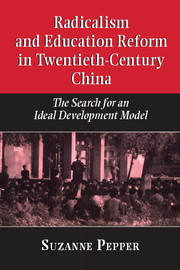Book contents
- Frontmatter
- Contents
- Acknowledgments
- 1 Educational development and the Chinese experience
- Part I The republican era: origins of radical education reform
- Part II Learning from the Soviet Union
- Part III Cultural revolution and radical education reform
- 11 On Stalin, Khrushchev, and the origins of cultural revolution
- 12 The great leap in education
- 13 A system divided: walking on two legs into the 1960s
- 14 Education reform as the catalyst for cultural revolution and class struggle: the 1966–1968 mobilization phase
- 15 Education reform as the culmination of class struggle: the professional educator's perspective
- 16 Education reform as the culmination of class struggle: the critical ideals triumphant at last
- 17 The Cultural Revolution negated
- 18 The mixed triumph of regularity
- 19 Chinese radicalism and education development
- Appendix: the Hong Kong interviews
- Select bibliography
- Index
18 - The mixed triumph of regularity
Published online by Cambridge University Press: 04 August 2010
- Frontmatter
- Contents
- Acknowledgments
- 1 Educational development and the Chinese experience
- Part I The republican era: origins of radical education reform
- Part II Learning from the Soviet Union
- Part III Cultural revolution and radical education reform
- 11 On Stalin, Khrushchev, and the origins of cultural revolution
- 12 The great leap in education
- 13 A system divided: walking on two legs into the 1960s
- 14 Education reform as the catalyst for cultural revolution and class struggle: the 1966–1968 mobilization phase
- 15 Education reform as the culmination of class struggle: the professional educator's perspective
- 16 Education reform as the culmination of class struggle: the critical ideals triumphant at last
- 17 The Cultural Revolution negated
- 18 The mixed triumph of regularity
- 19 Chinese radicalism and education development
- Appendix: the Hong Kong interviews
- Select bibliography
- Index
Summary
Contemplating the momentous events of the post-1976 years, interviewees were reserved in their expressions of liberation, relief, and revenge. A major reason for the caution was that in the late 1970s and even into the early 1980s, no one expected Deng Xiaoping's era either to last as long as it did or to continue without a major Maoist backlash. It was said, for example, that Education Minister Liu Xiyao – a moderate post-1976 holdover from the Science and Education Group – bowed out after only a short period in office, not because he opposed the new line and policies, but because he feared the consequences of implementing them. Interviewees were similarly fearful. And all were aware that the new orthodoxy was as uncompromising in demands for loyalty as its predecessor had been, while education remained a “front-line” issue. Circumspection therefore derived from a range of cross-pressures and contradictory emotions.
By and large, interviewees were nevertheless consistent in greeting post- 1976 changes with the same mixed reviews they had bestowed upon the education revolution itself, albeit in reverse. Just as disruption, class discrimination, and rural assignments had been deplored, so a return to regularity in all systems, their own return to town or regular career tracks, and an end to institutionalized class conflict appeared to be welcomed without reservation by all. Nor did anyone have a single kind word for Jiang Qjng. And Zhang Tiesheng fared no better, even though all accepted his original letter of protest as a spontaneous gesture like many thousands of others provoked by the 1973 examinations.
- Type
- Chapter
- Information
- Radicalism and Education Reform in 20th-Century ChinaThe Search for an Ideal Development Model, pp. 491 - 511Publisher: Cambridge University PressPrint publication year: 1996



